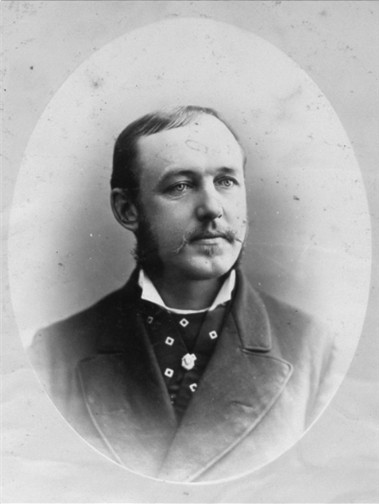|
NORTHERN PLAINS – PLATEAU
BEADED KNIFE SHEATH WITH PROVENANCE – ASSINIBOINE,
BLACKFOOT, PLAINS CREE, CROW, FLATHEAD, METIS OR SALISH
- A LARGE, VERY ATTRACTIVE SHEATH IN EXCELLENT CONDITION
WITH GREAT EYE APPEAL:
This is a beautifully executed Northern Plains or
Plateau beaded knife sheath, the body measuring just
over 10 ½” long and 2 ½” wide at the top opening. There
is an additional 15 ½” of fringe hanging below the tip
of the sheath. These floral designs were popular among
such tribes as the Assiniboine, Blackfoot, Plains Cree,
Crow, Flathead, Metis, and Salish peoples on the far
northern plains of Canada and on the western plains and
into the eastern plateau area of eastern Washington,
Oregon, Montana and Idaho in the United States.
The sheath is constructed
of native brain tanned hide which is fully lined with a
small check pattern cotton calico. The floral style
beadwork was exquisitely executed in very small seed
beads utilizing the very desirable early 19TH
Century colors in various shades. The strikingly
attractive designs were worked in three sections with
the upper and lower floral presentations divided by a
middle section of intersecting lines. The main panels
of beadwork are all edge beaded, including around the
top opening. The beadwork was applied in tight, well
executed contoured lines featuring shading with
complementary colors which provide depth and contrast to
the design elements – all evidence that the woman who
made this sheath was very skilled and experienced. All
of the beadwork is tight and intact with no loss or
loose strands.
The sheath is edged along
the seam with matching buckskin fringe which is wrapped
with two sections of porcupine quills - at the base and
midway along each piece of fringe – an uncommon value
added treatment which indicates this sheath was an
important project for the both the maker and the user.
All of the fringes are intact and full length, and the
quill wrappings have survived in very good condition,
showing very little wear.
The beads and hide show
aging and patina consistent with old beadwork and
evidence that this sheath was worn and used, and not
fabricated for the tourist trade. There is an old piece
of green silk ribbon tied through the belt slots
fashioned on the reverse, perhaps for hanging the sheath
from the original owner’s belt.
The sheath is accompanied
by an early Barclay & Brothers trade knife. It is
believed that Barclay was founded in Sheffield, England
in the mid-19TH Century, but beyond little is
known about the company. Their knives are not common,
so that may indicate that their years of operation and
their knife production was limited. Measuring 10 ½”
long in overall length, with a 5 ¾” single edged blade
which is legibly marked with “BARCLAY & BROS., EUREKA,
SHEFFIELD ENGLAND”. The blade shows evidence of use,
having been sharpened and the profile of the blade
slightly reduced – evidence of its long use. The blade
is overall smooth with a couple of small areas of
minimal discoloration and pitting, concentrated at the
tip. The wood handle scales are full form and intact,
in excellent condition with no checks or splits, and
still held firmly in place with the original iron pins.
Barclays knives were certainly traded out on the
frontier and blades of this size would have been popular
with the traders and Indians, certainly appropriate for
being carried in this sheath.
In spite of the obvious
signs of age and use, this sheath has survived in
excellent condition and displays very well. With such a
striking design and substantial size, this Beaded Knife
Sheath will be a dramatic addition to your collection,
and would a perfect piece to display on a Model 1876-79
Prairie Belt, one of the 1880’s Mills Cartridge Belts,
or on a civilian buffalo hunter’s cartridge belt.
SOLD
PROVENANCE:
Hayter Reed (1849-1936)

This knife sheath was obtained
from the collection of well known 19TH Century Canadian
politician and collector, Hayter Reed (1849-1936).
Reed, a native born Canadian, was educated in Canada and
after graduating from the School of Military Instruction
in Kingston, he joined the 14TH Battalion of Volunteer
Militia Rifles. He rose in the ranks to brigade major
and was transferred west to garrison duties at Ft.
Garry, the location of present day Winnipeg. Reed
studied the law and upon leaving military service, he
served in a number of government positions in the
Department of the Interior, eventually being appointed
as an Indian Agent in 1881, and Indian Commissioner in
1888. He headquartered in Regina, then identified as
being in the Assiniboia District, later as the capital
of Saskatchewan. Reed’s duties as Indian Agent and
Commissioner no doubt fostered his interest in the
material culture of the Native Peoples of the area and
led to his accumulation of artifacts into a collection
of some note. After his passing, not only were
artifacts sold to private collectors, but a considerable
number of pieces were donated to museums in Canada,
including the famous McCord Museum.
Saskatchewan was the home of a
number of reserves set aside for the First Peoples of
Canada, including such tribes as the Assiniboine – also
known as the Stone or Stoney Sioux, the Plains Cree, and
Metis, as well as other tribes which migrated back and
forth between the US and Canada with little regard of
the international border. These would include the
Blackfoot, Crow, Flathead and Salish. Reed would have
had the opportunity to collect pieces of material
culture from any and all of these tribes and he was
certainly in a position to build a substantial
collection.
I purchased this sheath from a
Canadian collector who in turn purchased it in Canada
from a dealer who was selling pieces of Hayter Reed’s
personal collection.
|

